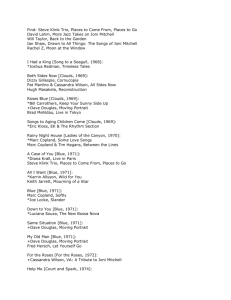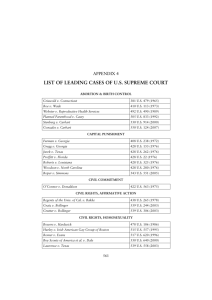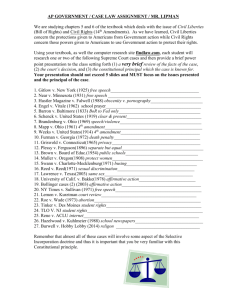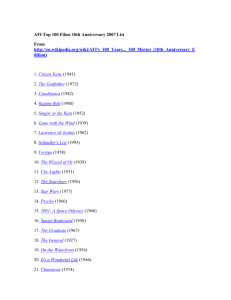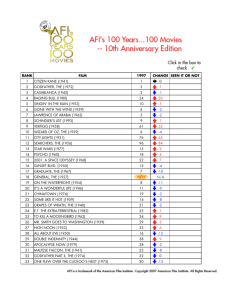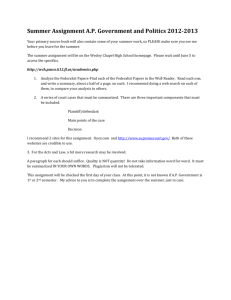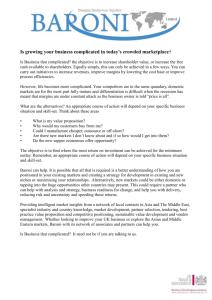Slides PPT
advertisement
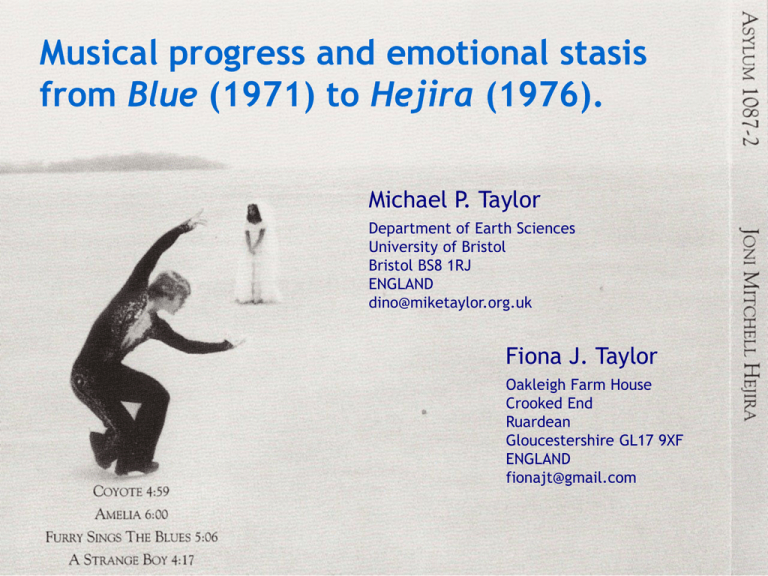
Musical progress and emotional stasis from Blue (1971) to Hejira (1976). Michael P. Taylor Department of Earth Sciences University of Bristol Bristol BS8 1RJ ENGLAND dino@miketaylor.org.uk Fiona J. Taylor Oakleigh Farm House Crooked End Ruardean Gloucestershire GL17 9XF ENGLAND fionajt@gmail.com Blue (1971) Hejira (1976) What happened in between? Blue (1971) Hejira (1976) For the Roses (1972) Court and Spark (1974) The Hissing of Summer Lawns (1975) Harmonic language Blue (1971) Hejira (1976) Complex guitar chords. Simple progressions. Simpler chords. More complex progressions. Harmonic language Blue (1971) Hejira (1976) Complex guitar chords. Simple progressions. Very little additional instrumentation. Simpler chords. More complex progressions. Rich instrumentation. Bass not underpinning chords, but acting as a solo instrument. Vocals Blue (1971) Timbre: clear, bright. Hejira (1976) Timbre: rich, gravelly. Vocals Blue (1971) Hejira (1976) Timbre: clear, bright. Pitch: high. Timbre: rich, gravelly. Pitch: about a third lower. Vocals Blue (1971) Hejira (1976) Timbre: clear, bright. Pitch: high. Range: wide. Timbre: rich, gravelly. Pitch: about a third lower. Range: narrower. Average lowest: G#3 Average lowest: G3 — a semitone below Average lowest: G#3 Average highest: D5 Average lowest: G3 — a semitone below Average highest: B4 — 2 tones below Average lowest: G#3 Average highest: D5 Average range: augmented 12th Average lowest: G3 — a semitone below Average highest: B4 — 2 tones below Average range: major 10th — 2 tones less Carey Average lowest: G#3 Average highest: D5 Average range: augmented 12th Amelia Average lowest: G3 — a semitone below Average highest: B4 — 2 tones below Average range: major 10th — 2 tones less Vocals Blue (1971) Hejira (1976) Timbre: clear, bright. Pitch: high. Range: wide. Intervals: large (an octave or more) Timbre: rich, gravelly. Pitch: about a third lower. Range: narrower. Intervals: small (mostly 2nds and 3rds) Song length Blue (1971) 10 songs min 2:50 (This Flight Tonight) max 4:20 (A Case of You) total 2141 seconds = 35:41 average 214 seconds = 3:34 Average song longer by 2:12 (62%) Hejira (1976) 9 songs min 4:15 (A Strange Boy) max 8:40 (Song for Sharon) total 3114 seconds = 51:54 average 346 seconds = 5:46 Lyrics Blue (1971) Hejira (1976) Relatively straightforward. Highly figurative & metaphorical. Themes of Blue songs Blue (1971) 1. All I Want — complicated relationship 2. My Old Man — complicated relationship 3. Little Green — baby born of a complicated relationship 4. Carey — complicated relationship 5. Blue — complicated relationship 6. California — travel 7. This Flight Tonight — complicated relationship 8. River — complicated relationship 9. A Case of You — complicated relationship 10. The Last Time I Saw Richard — complicated relationship Themes of Blue songs Blue (1971) 1. All I Want — complicated relationship 2. My Old Man — complicated relationship 3. Little Green — baby born of a complicated relationship 4. Carey — complicated relationship 5. Blue — complicated relationship 6. California — travel 7. This Flight Tonight — complicated relationship 8. River — complicated relationship 9. A Case of You — complicated relationship 10. The Last Time I Saw Richard — complicated relationship Themes of Hejira songs 1. 2. 3. 4. 5. 6. 7. 8. 9. Coyote — one-night stand Amelia — early aviation Furry Sings the Blues — urban decay A Strange Boy — complicated relationship Hejira — pilgrimage Song for Sharon — complicated relationship Black Crow — dislocation Blue Motel Room — complicated relationship Refuge of the Roads — travel Hejira (1976) Themes of Hejira songs 1. 2. 3. 4. 5. 6. 7. 8. 9. Coyote — one-night stand Amelia — early aviation Furry Sings the Blues — urban decay A Strange Boy — complicated relationship Hejira — pilgrimage Song for Sharon — complicated relationship Black Crow — dislocation Blue Motel Room — complicated relationship Refuge of the Roads — travel Hejira (1976) Effect of all changes Blue (1971) Hejira (1976) The work of a precocious girl Immature Self-obsessed Indecisive The work of an accomplished woman Mature Self-possessed Comfortable in her own skin Blue (1971) But! Hejira (1976) Themes Blue (1971) Conflict between commitment (= love) freedom (= career) = Hejira (1976) Conflict between commitment (= love) freedom (= career) Themes Blue (1971) Conflict between commitment (= love) freedom (= career) = Hejira (1976) Conflict between commitment (= love) freedom (= career) Emotional stasis Real theme of nearly all songs “We love our loving But not like we love our freedom.” — Help Me, Court and Spark. Blue (1971) Hejira (1976) Real theme of nearly all songs “The conflict between freedom for art's sake and the need for love forms the basis of most of her songs.” — Ariel Swartley. “The Siren and The Symbolist” (review of Hejira). Rolling Stone, 10 February 1977. Blue (1971) Hejira (1976) Real theme of nearly all songs “... a capricious lover resisting fantasies of domesticity even while the hausfrau within her was rattling around the kitchen in a constant huff about how fickle her own lovers seemed to be.” — Perry Meisel, “An end to innocence: how Joni Mitchell fails” (review of Hejira) Village Voice, January 1977. Blue (1971) Hejira (1976) Real theme of nearly all songs “If anything was really in Mitchell's blood like holy wine, it was the tension between romanticism and cynicism that recurred again and again throughout her career — a tension she seemed to revel in rather than show any real interest in resolving. She was too smart for either position, but also too smart to remove herself entirely from each.” — Alex McPherson, "Joni Mitchell: 10 of the best" (writing about A Case Of You) The Guardian, 30 April 2014. Blue (1971) Hejira (1976) Hejira is more integrated than Blue Blue (1971) The music expresses the conflict Even when the words skim over it. — — — — harmonic dislocation inconstancy instability misdirection Hejira (1976) 1. Harmonic dislocation Coyote (start of album) Guitar introduction in C. Vocal entry on E♭. 2. Inconstancy None of the songs has a chorus. Song for Sharon has ten verses. Not a single repeated lyric. Melody is subtly different in every verse. 3. Instability Most songs refuse to land on tonic. Amelia see-saws between two keys, a tone apart. 3. Instability Most songs refuse to land on tonic. Amelia see-saws between two keys, a tone apart. Refuge of the Roads melody is mostly on non-triad notes. Except “It made most people nervous”. Then lands back on 6th for “refuge”. 4. Misdirection “There's no comprehending Just how close to the bone and the skin and the eyes and the lips you can get ...” — Coyote 4. Misdirection “There's no comprehending Just how close to the bone and the skin and the eyes and the lips you can get And still feel so alone ...” — Coyote 4. Misdirection “There's no comprehending Just how close to the bone and the skin and the eyes and the lips you can get And still feel so alone And still feel related.” — Coyote 4. Misdirection “There's no comprehending Just how close to the bone and the skin and the eyes and the lips you can get And still feel so alone And still feel related.” — Coyote “We got high ...” — A Strange Boy 4. Misdirection “There's no comprehending Just how close to the bone and the skin and the eyes and the lips you can get And still feel so alone And still feel related.” — Coyote “We got high on travel ...” — A Strange Boy 4. Misdirection “There's no comprehending Just how close to the bone and the skin and the eyes and the lips you can get And still feel so alone And still feel related.” — Coyote “We got high on travel And we got drunk ...” — A Strange Boy 4. Misdirection “There's no comprehending Just how close to the bone and the skin and the eyes and the lips you can get And still feel so alone And still feel related.” — Coyote “We got high on travel And we got drunk on alcohol ...” — A Strange Boy 4. Misdirection “There's no comprehending Just how close to the bone and the skin and the eyes and the lips you can get And still feel so alone And still feel related.” — Coyote “We got high on travel And we got drunk on alcohol And on love, the strongest poison and medicine of all.” — A Strange Boy Blue (1971) Hejira (1976) Tells us to feel conflict Makes us feel it Does Hejira reach a conclusion? Last two songs: “You lay down your sneaking round the town honey And I'll lay down the highway.” — Blue Motel Room chooses security. Does Hejira reach a conclusion? Last two songs: “You lay down your sneaking round the town honey And I'll lay down the highway.” — Blue Motel Room chooses security. “It made most people nervous They just didn't want to know What I was seeing in the refuge of the roads.” — Refuge of the Roads chooses freedom. Does Hejira reach a conclusion? Last two songs: “You lay down your sneaking round the town honey And I'll lay down the highway.” — Blue Motel Room chooses security. “It made most people nervous They just didn't want to know What I was seeing in the refuge of the roads.” — Refuge of the Roads chooses freedom. Does Hejira reach a conclusion? “You lay down your sneaking round the town honey And I'll lay down the highway.” — Blue Motel Room chooses security. But Blue Motel Room is a lounge-jazz pastiche. Joni is playing a role. Does Hejira reach a conclusion? Refuge of the Roads is stylistically consistent with the rest of the album. “It made most people nervous They just didn't want to know What I was seeing in the refuge of the roads.” — Refuge of the Roads chooses freedom. Blue is ultimately about abandoning relationships So is Hejira Musical progress and emotional stasis from Blue (1971) to Hejira (1976). Michael P. Taylor Department of Earth Sciences University of Bristol Bristol BS8 1RJ ENGLAND dino@miketaylor.org.uk Fiona J. Taylor Oakleigh Farm House Crooked End Ruardean Gloucestershire GL17 9XF ENGLAND fionajt@gmail.com
